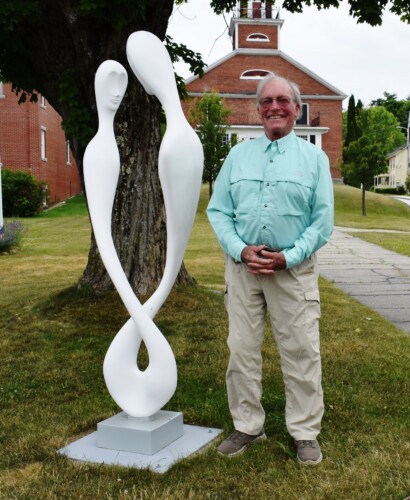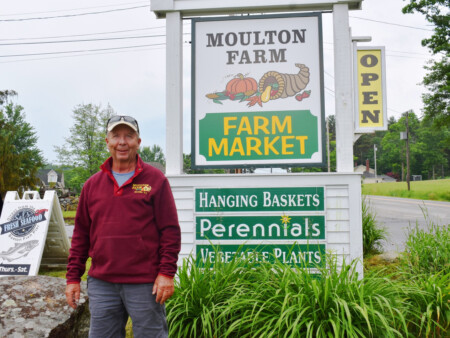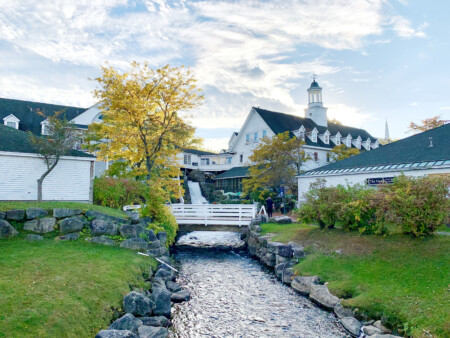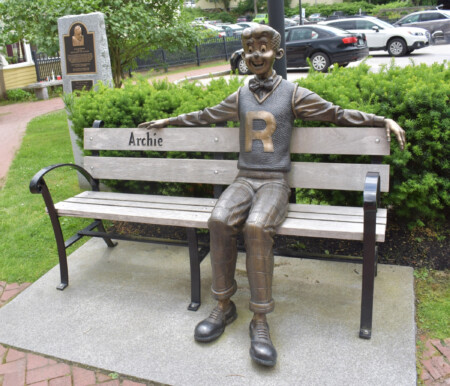Two years ago, Travel + Leisure magazine confirmed what a lot of people here already knew: Meredith is one of the “best small towns on the East Coast.”
While that acclaim resulted in a surge of visitors, longtime residents say it also fanned a hot real estate market that is centered on Lake Winnipesaukee and is based on the town’s current major industry: retirement.
“Travelers are looking beyond the bright lights of cities like Boston and New York and seeking out places with a lower concentration of visitors and easier access to the outdoors,” Evie Carrick wrote in the April 7, 2022, issue of Travel + Leisure.

Bev Lapham, of the Meredith Sculpture Walk, poses with one of the three art installations being considered for the cover of Sculpture Walk’s 2024 brochure.
Carrick described Meredith as “one of those almost unbearably cute East Coast towns — especially in the fall, when the colors pop.”
But before that happens, Meredith owns the summer.
“The town is right on Lake Winnipesaukee in the foothills of the White Mountains and home to one of five ports, from which that the historic M/S Mount Washington sails,” Carrick wrote. “For a perfect Meredith day, kayak to the nearby Stonedam Island and back, then go for a sunset dinner cruise on the ship.”
Like so many towns in New Hampshire, Meredith’s rise to retirement haven and resort community is rooted in the state’s industrial past.
Beginning in the early 18th century, Meredith Village -— the area between lakes Waukewan and Winnipesaukee — was the site of several mills. When that era passed, it was superseded by the current hospitality industry, said John Hopper, president of the Meredith Historical Society.
With hotels and restaurants on and near Meredith Bay, Meredith — thanks to its location on Lake Winnipesaukee, and blessed with several other water bodies — has become a year-round destination.
Meredith has grown, as people who first came as visitors have bought second homes or moved here permanently. The folks in the latter group, said Hopper, are generally older and wealthier than many members of the community they are joining.
In 2022, the town had a year-round population of about 6,600. Nearly half of its residents were 55 or older, according to state figures. Meredith has a per-capita income of $43,176 and a median household income of $61,359.
Most of the town’s 5,200 housing units are single-family properties, according to the state. In May, the median-sale price of those properties was $725,000, according to New Hampshire Realtors.
“I think affordable housing is the biggest problem in Meredith that has to be faced in the next 10 to 20 years,” said Bev Lapham, who settled in Meredith 35 years ago with his wife, Liz, after a career in banking in New York and Connecticut.
Housing costs are soaring across the board, he said, while the prices of “lake properties are just astronomical.”
A village beckons

John Moulton stands in front of the sign for Moulton Farm, which began operating in the 1890s and which has remained popular well into the 21st century.
Meredith is a great place to be, said Lapham, who added he has been impressed and appreciative of the spirit and breadth of voluntarism in the community, including for the Meredith Sculpture Walk, a rotating series of 32 art installations in Meredith Village and in Hesky and Scenic parks, that is a year-round attraction.
“My wife and I visited our son, who was working here, a bunch of times and we fell in love with the village, and when I made a career move and bought a business (Village Canvas) here, that sort of sealed the deal,” Lapham said.
He conceded, however, that the “deal” was sealed before then by his wife.
“We decided that New England is where we wanted to be, and we stayed in Meredith while I was looking around for a business,” he said. “And the longer I stayed here, the more my wife said, ‘You can find a business anywhere you want, but I’m staying in Meredith.’”
The couple’s decision, he added, was made simpler because they are both avid boaters. And there are plenty of spots for that in Meredith.
The 40-square-mile town includes more than 14 miles of inland water area, with Lake Winnipesaukee comprising the largest share of waterfront. It also includes Lake Waukewan and Lake Wicwas, as well as parts of Lake Winnisquam and Pemigewasset Lake.
Mountain’s midway
Because it’s between Laconia, the seat of Belknap County, and Plymouth, home to Plymouth State University, Meredith has long been a bedroom community for those two municipalities.
Since the early 20th century, Meredith has billed itself as the “Latchkey to the White Mountains” because it was in the middle of the roads to get to and back from the mountains, Hopper said.
Meredith was also aware that it was increasingly a destination in itself, he said. In 1982, the town did a study and embraced that its future lay in hospitality. Two years later, that future took form when Rusty McLear opened the Mill Falls Market Place and, later, other lodging establishments on Meredith Bay, all of which he has since sold.

A visit or stay at the Mill Falls property offers the opportunity to stroll, shop and dine at The Marketplace. The bridge is a favorite spot to pose
for a picture in front of the cascading waterfall.
“That was a massive change for the town,” said Hopper, noting that it followed a demographic change in the 1970s when Meredith saw both year-round and seasonal populations increase by 30 percent.
The town has seen “crazy” development since 2000, said Hopper, with the COVID-19 pandemic bringing many new residents and businesses.
Serving the influx of retirees among the arrivals has been described as the town’s biggest industry, joked Hopper and Rudy VanVeghten, a board member of the historical society. While that is wonderful from many standpoints, they said, it also puts pressure on locals to be able to afford to live where they grew up.
At its settling in 1768, Meredith was based on an agrarian economy, but since the 1800s, its core, Meredith Village, was dominated by mills — lumber, grist, textile and then stocking/hosiery — all of which were powered by water flowing east, down from what is now known as Lake Waukewan, via the now mostly-built-over Measly Stream that enters Lake Winnipesaukee at Meredith Bay.
Despite each mill employing an average of 150 people in succession, Meredith, to use a baseball metaphor, was always “a single-A team,” said Hopper. He compared it to the “big leagues” of river-fed mills in Laconia, Franklin, Manchester and Nashua and the Massachusetts communities of Haverhill and Lowell.
Regardless of how small they were, the mills were “always the largest employer in town,” said Hopper, “and as the mills went, the town went.”
When the last mill closed, sending Meredith into an economic tailspin, a Pennsylvania-based company decided that the heart of Meredith Village was the ideal place to process asbestos. The March 1, 1951, edition of the “Meredith News” trumpeted in a headline that “Meredith can breathe again.”
“We were all ignorant in those days” about the danger of asbestos, said Van Veghten, who worked at the Meredith News from 1973 until 2000, spending all but four years there as editor. Gradually, awareness of the problems created by asbestos grew, and Meredith’s asbestos plant closed in 1979, he said.
That time, coincidentally, was when town leaders, with McLear’s help, firmly put Meredith on the travel-and-tourism map.
John Moulton, owner of Moulton Farm, which has been in operation since the 1890s, quipped that at age 8 or 9, his father consigned him to selling pumpkins from the bed of a pickup parked on NH Route 25, an action that today could be considered “child abandonment.”
The Moulton Farm began as a dairy, he said, but it and other small-scale dairies eventually consolidated or closed, unable to keep up with the bigger players in the industry.
Moulton said his late father, seeing how things were trending, made sure he and his brother were educated well. He added that after he graduated from the University of New Hampshire with a degree in education, he went to teach at Pinkerton Academy for 17 years.
While he loved teaching, Moulton said he wasn’t happy about the long commute to and from Meredith, so he continued farming during the summers, returning full-time to his fields in the mid-1990s and eventually adopting a direct-to-consumer model that remains to this day.
The COVID-19 pandemic brought a lot of new customers to Moulton Farm, he said, and they keep coming.
Among his many concerns, said Moulton, is the quality of water in Lake Winnipesaukee, finding enough employees, and finding them places to live.
“We’re always running about 15 percent short on good, skilled help, and the labor thing could be and probably is restrictive to the economic growth of the entire area,” he said.
That said, Meredith has some very strong roots thanks to McLear and others, Moulton summed up with Hopper and Van Veghten, pointing out several of the town’s other attributes: hosting the annual Pond Hockey Classic and the Great Meredith Rotary Ice Fishing Derby, and being home to the delightfully eclectic Innisfree Bookshop.
Annalee and Archie
Since 1934, the town has been home to Annalee Mobilitee Dolls; and it is where the late Bob Montana created characters for Archie Comics. A sculpture of the freckled Archie Andrews was recently placed on a bench in a pocket park downtown.

The late Bob Montana, who created characters for Archie Comics, spent his childhood summers in Meredith and later lived with his wife and children there. A sculpture of the freckled Archie Andrews was recently placed on a bench in a pocket park downtown.
Meredith was featured in the “Betrayal” episode, aired March 5, 2008, of the popular TV show “Law & Order,” and it boasts, among many eateries, Hart’s Turkey Farm Restaurant and George’s Diner.
Meredith has a roundabout at the intersection of routes 106 and 3 that actually works quite well, but it also has frequent and long traffic delays at the intersection of routes 3 and 25. There’s lots of parking, though, in Meredith Village, including at the aptly named and municipal Town Docks.
Despite the occasional challenges of getting into and out of Meredith, visitors are not deterred. When asked about what they see as the future of Meredith in 15 to 25 years, Hopper said he and Van Veghten don’t foresee many changes, adding that they “won’t be worrying about it” because they’ll probably be dead by then.
Meredith “will always be a draw because of the lake,” Hopper said. “It’s hard to imagine what else we could be,” he said, other than a residential resort community on the biggest lake in the Granite State.
